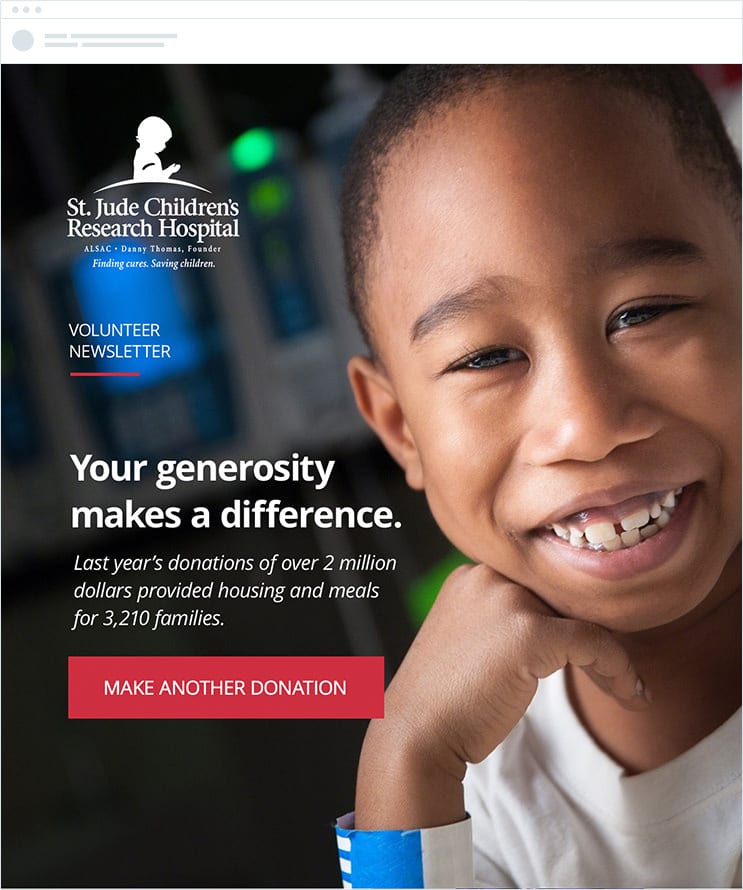‘Tis the season for holiday shopping, family feasts, and gift giving. The last few months of the year are a busy time for everyone, including nonprofits. While retailers are busy with glitzy sales events featuring the year’s must-have items, nonprofits are also working hard to capitalize on the season of giving. Joining the ranks of Black Friday and Cyber Monday, we also have #GivingTuesday, a global day of giving back which occurs on the Tuesday after Thanksgiving.
About 50 percent of organizations receive the majority of their donations between October and December, according to a GuideStar survey. In 2015, the average U.S. donation was $137 with over 698,961 donors and a total of $358.4 billion according to Giving USA.
With so much riding on the last few months of the year, it’s important to use email marketing as a donation vehicle.
The good news is, there’s still time to ask subscribers for their support before the end of the year. To help you create emails that tap into the spirit of the season, here are five emails nonprofits can send to generate donations.
1. The gift guide email
During the holiday season, people need a little help in the gift department. To provide inspiration, businesses create gift guides to showcase must-have presents.
Why not try creating a gift guide for your nonprofit? The Red Cross does. Rather than simply asking for a specific monetary donation, this nonprofit and Campaign Monitor customer shows its subscribers what gifts can be bought with those donations.

For example, $25 buys five blankets for a displaced family, or a donation of $100 provides meals for 10 people.
This handy gift guide turns donations into tangible gifts. By showing subscribers what their donation can do, it makes an emotional connection that encourages more subscribers to act.
It’s a great alternative to the standard “please give money this holiday season” email.
To create a gift guide, here are a few tips:
- Set a variety of donation amounts – From $5 to $500, every donation counts so make sure your holiday guide includes amounts that fit every budget.
- Be visual – Show subscribers what “gifts” their donations provide with great images. To help subscribers make a connection, use images of real people whenever possible.
- Include a call to action – Make sure the gift guide provides a clear call to action that directs subscribers to a shopping or donation page.
- Include a shareable link – Ask your subscribers to share the gift guide with others by including a link that allows them to share it.
2. The story email
There’s power in storytelling. If your organization helps those in need, share stories with subscribers to help them understand how important their donation is.
Sure, you could explain that a $10 donation feeds a homeless person for one night, but you can go further than a simple explanation. Don’t just tell donors how their gifts help, show them.
Ask a few people that your organization helps to share their story. You’ll be surprised at the number of people who are willing to share their story as a way to thank your organization for the services provided.
Once you have a few willing volunteers, interview each person, learn about his or her situation and tell their story to your subscribers.
You can create a short article and include it along with a call to action to donate in an email. Here’s an example from UNICEF:

In this example, the brief story of a thirteen-year-old girl, Fatima, helps describe the need for people to act. In this case, UNICEF is asking subscribers to sign a petition.
Here are a few storytelling tips:
- Tell a story, not a promotion – The story should focus on a person, not how your organization saved the day. Mention how you help, but make sure the story is fueled by the details and emotion of the person in need.
- Include a picture – Make sure you share a picture of the person; it brings the story to life.
- Make a connection to the holiday season – After telling the story, mention your need for holiday donations, or if you can tell a story about someone in need during the holidays that’s even better.
- Consider including a video – Creating a video has never been easier. Consider telling a story through video and sharing a link to it via email and on your social sites.
3. Refresher email
The holiday season is a good time to remind donors what your organization is all about.
Create an email that outlines your organization’s mission and the good it does. Consider adding a bulleted list that outlines the number of people helped, and next year’s goals. Or, create a short video that looks back at this year’s accomplishments, explains new initiatives for the year to come or reminds donors about the year-round need.
Check out this example from St. Jude:

The purpose of this email is to inform and solicit donations. Remember, you need to send a diverse variety of emails, even during the holiday season. If you send too many purely “please donate” emails, you may turn people off. Remember, they may be, and probably are, getting many requests for donations this time of year.
A refresher email is the type of email that builds trusts between you and your donors while offering a crash course in why your organization is worth donating to.
Here are a few tips to create a refresher email:
- Keep it short – Donors are always busy, but even more so during the holiday season, so keep it brief.
- Consider creating a video – Emails with video have a 53% higher click to open rate than those without. It’s worth taking a little time to create a short (1-2 minute) video this season.
- Help donors learn more – Provide links to your website and social channels in the email to help donors continue their learning process.
4. The event email
A lot of nonprofits host holiday events. Whether you’re hosting your annual gala, coat drive, food collection or charity auction, use email to invite guests.
Be sure to explain what the event is and tell donors what to expect. Encourage guests to come by explaining what’s in it for them.

Once you send out your initial email, you can use marketing automation to send reminder emails as the event gets closer.
Tips to create and send an event email:
- Double check the details – Run through your email and make sure all of the information is correct. You don’t want to send an invitation with the wrong date or address.
- Offer perks to those who RSVP early – Give early bird RSVPers something special like a free t-shirt, a chance to win a giveaway or a VIP tour of your facility.
- Create an event on Facebook – To cross-promote your event, create a Facebook event and let people RSVP. Facebook explains how to set up an event in five easy steps.
- Provide additional information in reminder emails – When you remind people about your event via email, offer additional information like parking suggestions or a list of speakers featured at the event.
5. The thank you email
When a donation is made, you should follow up with a thank you. It’s important to show gratitude to donors, no matter how big or small a donation is.
The Red Cross takes the thank you email one step further by explaining exactly where the donation went.

The email thanks the donor for his donation of blood and explains that the donation is headed to a specific hospital. It also encourages the donor to share his good deed on social media. It even uses a specific hashtag, #RedCrossOnTheWay, that the donor can use.
This follow up email accomplishes a lot. It says thanks, follows up on the donation and encourages the subscriber to share some social love on Facebook and Twitter.
Here are a few tips to create and send a thank you email:
- Say thanks – A simple message of gratitude should be the first item in the email.
- Reinforce the decision – Remind the subscriber why their decision to donate to your organization was a great one.
- Cross-promote – The Red Cross uses a thank you email to promote a social campaign. It’s a great example of cross promotion; one that could drum up more support during the holidays.
Wrap up
As the end of the year approaches, you don’t have to scramble to find email inspiration for your next donation drive – it’s all right here for you. Use these five examples to create effective emails that collect the donations your nonprofit needs to succeed.
Send emails that generate donations
Campaign Monitor's drag and drop email builder makes it easy to send beautiful emails that generate donations